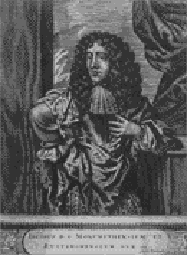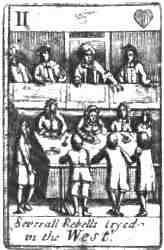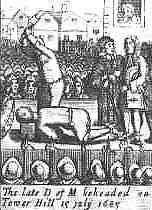home | Nicholas Willmott
family history
The Duke of Monmouth
WIL(L)MOT(T)S AND THE MONMOUTH REBELLION
To practice properly the science of genealogy requires a great capacity for precision and taking pains. These are qualities that I lack! Nevertheless, knowing that the present generation of our family has Somerset origins, I was intrigued to learn that the name of Willmott crops up frequently in the annals of the Monmouth Rebellion.
This summer [1996] I took advantage of a short holiday in the West Country to make a superficial search through the archives section of the Somerset County Library in Taunton. These notes are the result.
There is no suggestion that we are definitely descended from the individuals mentioned. To demonstrate a link would require a great deal of further work and could, even then, prove inconclusive.
On the 11th June 1685 James, Duke of Monmouth, illegitimate son of Charles II, landed with some 80 followers at Lyme Regis. His intention was to raise a citizen army to overthrow the increasingly unpopular James II.
Over the following days many people from West Dorset, East Devon and Somerset threw in their lot with Monmouth. They were not the ignorant pitch-fork bearing peasants of popular myth. Neither were they young hotheads out for excitement and adventure. Recent research clearly demonstrates that most of them were well-established farmers, smallholders and artisans - especially cloth industry craftsmen, together with a number of professional people and gentry. Many were members of nonconformist churches seeking a measure of religious tolerance. Others, harking back to the Commonwealth, sought rule by parliament.
The story of how Monmouth’s rebel army, never more than 8,000 strong, marched and counter-marched through the West Country, and its eventual defeat on the 5th-6th July at Sedgemoor is well known. The aftermath; Monmouth’s execution and Lord Chief Justice Jeffreys’ “Bloody Assizes”, is also familiar history.
Thanks largely to the thoroughness of 17th century bureaucracy a great deal of detail has survived regarding the rebels and their fate. When the uprising had been suppressed local constables were required, under threat of severe penalty, to compile lists of persons absent from their homes during the rebellion, presumably with Monmouth’s army. As well as court and prison records, Jeffreys’ submitted formal reports to King James. Contemporary newsletters list the fate of those indicted. The names of those condemned to transportation appear, like so much cargo, on shipping documents. The rebels were also commemorated in various editions of The Western Martyrology, first published in 1689.
In all the names of some 4,000 of the rebels are known and are most comprehensively listed in W.M. Wigfield’s Roll of the Monmouth Rebels published by the Somerset Record Society. The other rebels either managed to avoid detection or were killed at or immediately after the debâcle at Sedgemoor. Their identities have not been established.
Of the 4,000 known rebels seven bear the name of Willmott (see note on spelling). Given that the surname is moderately uncommon this is quite a high proportion and reflects the numerical strength of the Willmott family in those West Country areas where Monmouth raised his army. Below I record such details as are known:
Edward Willmott (1). Was tried by Jeffreys at the Dorchester Assize opened on 5th September. The proceedings took place in the Oak Room of the Antelope Hotel, which still exists. He was one of 320 men accused of “Levying Warr against the King”. A subsequent broadsheet List of the Names of the Rebells That were Executed ... with the names of those which were Respited till further Orders ... lists him as having been “respited”. This meant transportation to the West Indies to be sold as a slave. Edward was ‘given’, presumably at a price, to the merchant, Sir William Booth. On September 25th the prisoner sailed on the ironically named Happy Return from Weymouth bound for Barbados. The ship arrived on or shortly before 8th January 1686. Edward was then sold on to one Peter Flewilling.
 Playing card showing Monmouth rebels on trial.
Playing card showing Monmouth rebels on trial.Edward Willmott (2). The namesake of the above was tried by Jeffreys at the Wells Assize opened in the Market Hall on 22nd September. By this time Jeffreys had become remarkably efficient in the administration of his brand of justice. The rebels had also learned from bitter experience that summary execution almost invariably followed a plea of not guilty. Edward was probably one of no less than 543 rebels who came to trial on 23rd September. If so he was one of the 542 who, predictably, pleaded guilty. The one individual who entered a plea of not guilty was executed the same afternoon.
Edward’s eventual fate was also transportation. Sir Philip Howard, Governor of Jamaica, was to be ‘given’ 200 transportees. He complained that 25 of them ‘had made their escape from the Guards betwixt Wells and Sherburn [Sherborne]’ and that three more had escaped ‘out of the prison at Sherburn’. The memoirist, Thomas, Earl of Ailesbury cynically but no doubt accurately observed of the rebels that ‘the rich escaped’.
In any event Edward was unable to make a getaway. On October 25th he sailed on the Port Royal Merchant to Jamaica.
George Willmott. Was tried at the Dorchester Assize on September 10th and was sentenced to death by Judge Jeffreys. In an attempt to discourage further rebellion those executions that were carried out involved the full cruelty of hanging, drawing and quartering. The actual executions were deliberately spread throughout the rebel region. If this were not sufficient intimidation, it was ordered that the resulting body parts, preserved with salt and pitch, were to be distributed still further for display on gibbets erected all over the West Country.
George Willmott was executed, with eleven other rebels, at Weymouth or Melcombe Regis on September 16th.
Nowadays they are virtually the same town, then they were two separate boroughs. The Melcombe Regis Corporation archive includes the following document:
Order for a gallowes to be erected whereon 12 were to be executed and their quarters and heads distributed at several places.
To Upway 4 Quarters and 1 head
Sutton Points 2 1
Osmington 4 1
Preston 2
Weeke 2
Winfrith 4 1
Broadmaine 2 1
Radipol 2
Winterborne St. Martin 2
Puddletowne 4 1
Bincombe 2
32 [actually 30] 6
The rest in Waymouth and Melcombe Regis.
At the grand Piere 6 Quarters and 1 Head
Waymouth town’s end 2
Neere the Windmill 4 1
Waymouth Town Hall 2
On the Bridge 1 2
Melcombe Towne hall 1 2
16 6
The boroughs’ accounts show that ‘Burning and Boyling the Rebells executed att this town’ cost a total of £16-4-8. It appears that one of the gibbets failed for the town archives meticulously record a payment on 20th November ‘for new setting up a post with the quarters of the Rebells att Waymouth Towne-End’.
Hugh Willmott. Was tried with Edward(1) at Dorchester and had exactly the same fate. However, when he arrived in Barbados he was sold to a John Burston. In the List of the Rebells ... referred to above, as well as in the ‘Certificate of Capt. Kendall’s Prisoners delivered in Barbados ... on board the Happy Returne ...’, Hugh and Edwards’ names have been entered close to each other which suggests that they might be close relatives.
There is a curious postcript. Unlike some of the other transported Monmouth rebels, there is little evidence to suggest that any of the Willmotts established themselves in the Caribbean. Many of the transportees perished under the harsh conditions of slave life. After the Glorious Revolution of 1688 the surviving rebels were eventually pardoned and some returned to their homes in the West Country or travelled on to America. It is estimated that less than a quarter of all those transported eventually returned to their homes.
The Barbados Birth and Marriage records are surprisingly complete but mention no Willmotts between the years 1685 and 1800. However the faintest of echoes can be found in the will of one Marshall Thomas of St. Philip Parish, Barbados, dated 1st December 1694. This mentions ‘Hugh Willmoth’ as a friend of the testator.
John Willmott. Was a native of Ilminster. The Constables’ Presentments of those absent from their homes during the rebellion describe him as being ‘out in the rebellion’. He appears to have been one of 54 recruits enlisted in Monmouth’s army which was in that town on 17th June. In the absence of any resulting court proceedings it may be assumed that John managed to evade arrest.
Odes Willmott. Resided in Stoke St. Gregory, a village some six miles East of Taunton. His indictment appears in the Somerset Quarter Session Rolls. He was charged with ‘not coming to church for a month, and for assisting one of the rebels in stealing of a mare’. The outcome of the case is not recorded.
‘Odes’ is a most unusual fore-name. It does not appear in The Oxford Dictionary of English Christian Names. I suspect that, given the vagaries of Stuart period handwriting, it is a corruption of something else. William Camden in his Remains Concerning Britain of 1605 lists ‘the names which we now call Christian names most usual to the English nation’. He includes ‘Odo’ which could well be the correct form of ‘Odes’.
Richard Willmott. Came from Colyton, a township some five miles West of Monmouth’s landing point in Lyme Regis, and worked as a mason. Colyton was celebrated as a centre of Dissent and seems to have contributed no fewer than 86 recruits for Monmouth’s army. This represented about a quarter of the town’s adult male population. Of these 33 were captured after Sedgemoor, including Richard who was imprisoned at Ilchester. Two managed to escape from captivity in Exeter. Two others were pardoned. The remaining 29 were convicted; 20 at Dorchester, four at Taunton, three at Exeter, and Richard, with one other, at Wells.
13 of the 29 were subsequently executed at locations throughout the region. The leader of the Colyton men, Roger Satchell, was executed at Weymouth together with George Willmott.
Richard was one of the 16 whose sentences were commuted to transportation. He was transported for Sir Philip Howard and sailed with Edward(2) on the Port Royal Merchant to Jamaica.
Only three of the transportees are known to have eventually returned to Colyton. Richard was not one of them.
A Note on Spelling:
The standardisation of spelling is a relatively recent invention. Of all classes of words the spelling of personal names is the least stable. It is only within the last century that names have been spelled with any consistency. ‘Willmott’, a diminutive of ‘William’ via ‘Williamott’ is no exception. In the seventeenth century, and indeed for many years afterwards, the name could be spelled in many ways and with doubling of consonants according to the whim of the writer.
Typically Hugh, mentioned above, appears as ‘Willmot’ in the List Of the Names of the Rebells and as ‘Wilmott’ in the ‘Certificate of Capt, Kendall’s Prisoners’. Later still it would seem that it is he who is referred to as ‘Willmoth’. Thus an inconsistency of spelling is no reason to suppose that two persons of similar name are not closely related. Wigfield in his Roll of the Monmouth Rebels solves the problem by listing all the above people as ‘Wilmott’.
Given the word of mouth manner in which Monmouth’s army was recruited, and the fact of the area concerned being an acknowledged Willmott family enclave, it seems entirely possible that some or all of the seven known Willmott rebels were related.
 The execution of the Duke of Monmouth.
The execution of the Duke of Monmouth.The Monmouth Rebellion is often written off as one of the great lost causes. Only a few years later James II was overthrown in the bloodless revolution that placed William and Mary on the throne.
In spite of the courage and devotion of his followers Monmouth’s whole campaign was dogged by ill luck. Even at its end, had chance dictated otherwise, the bold rebel night-time attack at Sedgemoor could well have succeeded. It is entertaining to imagine what might have been the course of British history had this been the outcome. As some of Monmouth’s earliest supporters, it is tempting to think that the artisan branches of the Willmott family would have come out of it rather well.
In any event it is proper that we should remember those who rose up and fought bravely against autocratic government and religious persecution and who suffered harshly in consequence.
Postscript, December 2000:
While the current Barbados telephone directory lists nobody with any of the variant Willmott spellings, the Jamaican directory records 121.